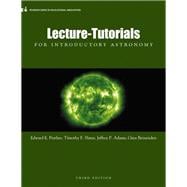
Note: Supplemental materials are not guaranteed with Rental or Used book purchases.
Purchase Benefits
What is included with this book?
Edward Prather is the Executive Director of the Center for Astronomy Education (CAE) and Associate Professor of Astronomy in Steward Observatory at the University of Arizona. Over the past fifteen years, Ed has been dedicated to improving Earth, Astronomy, and Space Science education through research, curriculum and assessment materials development, and instructor professional development on teaching and learning. He is also the recipient of the 2007 University of Arizona’s Provost Education Prize, the 2009 University of Arizona’s College of Sciences Innovations in Teaching award, and the 2011 American Association of Physics Teacher’s Halliday and Resnick Award for Excellence in Undergraduate Physics Teaching.
Tim Slater is the University of Wyoming Excellence in Higher Education Endowed Chair of Science Education. He holds appointments as Professor in both the Department of Physics & Astronomy and the College of Education. An award-winning professor with more than 100 publications, he has spent the last six years as the Education Officer of the American Astronomical Society and served on the Board of Directors for the National Science Teachers Association, the Astronomical Society of the Pacific, and the Society of College Science Teachers.
Jeff Adams earned his Ph.D. in theoretical physics from Queen's University, in Kingston Ontario, Canada. After also becoming a certified high school mathematics and physics teacher, he joined the faculty at Montana State University, Bozeman, where he taught physics and astronomy, mentored graduate students, conducted research on student learning, and developed curricular materials for use in introductory physics and astronomy. In spring 2002, he received the College of Letters and Science award for outstanding teaching. Jeff is currently the Associate Provost for Academic Administration at Millersville University.
Gina Brissenden is the Associate Director of the Center for Astronomy Education (CAE) and a Science Education Research Specialist in Steward Observatory at the University of Arizona. She is also the former Education Specialist for the American Astronomical Society. Gina’s work focuses on improving Earth, Astronomy, and Space Science education through research, curriculum and assessment materials development, and instructor professional development on teaching and learning.
The Night Sky
Position
Motion
Seasonal Stars
Solar vs. Sidereal Day
Ecliptic
Star Charts
Fundamentals of Astronomy
Kepler’s Second Law
Kepler’s Third Law
Newton’s Laws of Gravity
Apparent and Absolute Magnitudes of Stars
The Parsec
Parallax and Distance
Spectroscopic Parallax
Nature of Light in Astronomy
Electromagnetic (EM) Spectrum of Light
Telescopes and Earth’s Atmosphere
Luminosity, Temperature, and Size
Blackbody Radiation
Types of Spectra
Light and Atoms
Analyzing Spectra
Doppler Shift
Our Solar System
The Cause of Moon Phases
Predicting Moon Phases
Path of the Sun
Seasons
Observing Retrograde Motion
Earth’s Changing Surface
Greenhouse Effect
Temperature and Formation of Our Solar System
Sun Size
Stars, Galaxies, and Beyond
H-R Diagram
Star Formation and Lifetimes
Binary Stars
Motion of Extrasolar Planets
Stellar Evolution
Milky Way Scales
Galaxy Classification
Dark Matter
Looking at Distant Objects
Making Sense of the Universe and Expansion
Hubble's Law
Expansion of the Universe
Expansion, Lookback Time, and Distance
“Big Bang”
The New copy of this book will include any supplemental materials advertised. Please check the title of the book to determine if it should include any access cards, study guides, lab manuals, CDs, etc.
The Used, Rental and eBook copies of this book are not guaranteed to include any supplemental materials. Typically, only the book itself is included. This is true even if the title states it includes any access cards, study guides, lab manuals, CDs, etc.